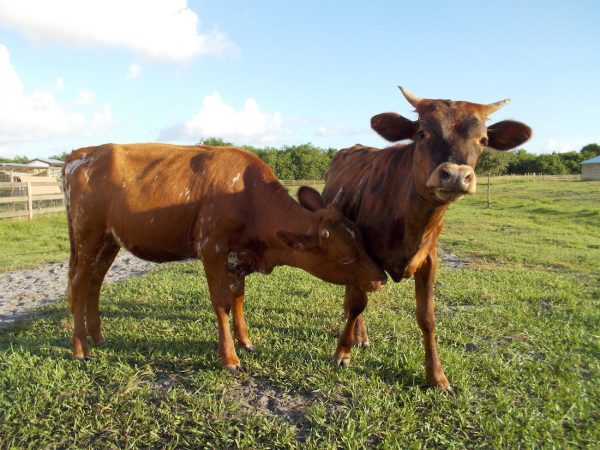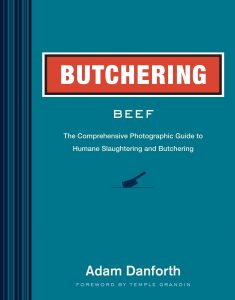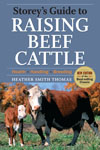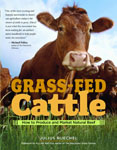
Status:
Threatened
Use:
Beef, Milk, Draft
Adult Weight:
600 – 1200 lbs. Dwarf <500 lbs.
Temperament:
Docile; can be active
Experience Level:
Novice – Intermediate
Notes:
Temperament variable by herd; good beef production on poor range; some are dwarf
Country of Origin:
United States
FLORIDA CRACKER CATTLE
The Florida Cracker is one of the oldest breeds of cattle in the United States, descending from Spanish cattle brought to the Americas in the early 1500s. As the Spanish colonized Florida and other parts of the continent, they established typical Spanish low-input, extensive cattle-ranging systems. The Florida Cracker and other breeds that developed under these conditions are called “Criollo” cattle, which means, “of European origin but born in the New World.”
Florida Crackers were shaped primarily by natural selection in an environment generally hostile to cattle. This resulted in a heat-tolerant breed that is long-lived, resistant to parasites and diseases, and productive on the low-quality forage found on the grasslands and in the swamps of the Deep South. It was not until the importation of India’s Zebu cattle and the development of the American Brahman in the 1900s that the Florida Cracker had competition from other heat-tolerant cattle. Not long afterwards, the development of parasiticides and other medications allowed British and European breeds to survive in the Deep South, thus diversifying the population of cattle in Florida. This influx of new breeds nearly caused the extinction of the Florida Cracker.
By the mid-1900s, most purebred cows had been crossbred, first to Brahmas and then to British and European breeds. The Cracker cow provided the maternal ability and hardiness necessary for crossbreeding programs to succeed and the genetic distance between the Florida Cracker and other breeds created exceptional hybrid vigor in the offspring. The credit for success, however, was always given to the “improved” breeds, and the Florida Cracker was largely abandoned. It was only through the efforts of a few Florida families, stubbornly resistant to “progress,” that the breed survived in its pure form.
Horn style and shape vary, including very long and twisted horns as well as smaller, more crumpled shapes. It is likely that the low nutrition level of the unimproved and unfertilized range and pastures and “the scrub” where the cattle lived affected the horn size and shape of the original Cracker cattle. Unlike their cousins, the Texas Longhorn, Cracker cattle horns tend to go up rather than out wide, an adaptation to the scrub brush and low-hanging tree limbs found in the area in which they lived; the wide horns would have made it difficult for them to navigate. Horns of some of the oldest Cracker cows that are distinctive of the breed go up quickly but not far, then turn back to form a sort of lyre shape. Horns that are wide at the base indicates outside influence, likely Brahman. Polled Florida Cracker cattle are also found.
As would be expected of cattle adapted to the heat, Florida Cracker cattle are smaller, with cows ranging in size from 600-800 lbs. and bulls about 800-1200 lbs. The very small dwarf type, called “Guineas” weigh no more than 500 lbs. (Guinea Crackers were highly regarded as milk producers.) They exhibit the angular conformation typical of Spanish cattle adapted to harsh conditions. The larger varieties are more likely to have descended from the Cracker cattle in the northern region selected for a larger size and more of a “beef type” conformation. The larger type may also include what are called “Piney Woods” cattle in Georgia, Alabama, and Mississippi.
Colors include almost all known cattle colors. This is a legacy from the breed’s ancestors in southern Spain, where even today ranchers prefer multicolored herds. In Florida, breeders also selected for specific colors and patterns to aid in recognition of their cattle on-range. Generally, solid red, dun, black, and brindle colors predominated in south Florida herds, while northern Florida herds were more likely to contain spotted and roan animals, some with distinctive color-sided and linebacked patterns.
The breed is hardy and strong, parasite resistant and self-sufficient, and able to survive on the rough pasture and swamp forage of the South. They are good mothers, long-lived, and easy keepers. As a triple-purpose breed, they are a good choice for a family farm as not only can they provide meat and milk, but they make outstanding oxen.
The state of Florida has been a leader in the conservation and promotion of the Florida Cracker breed in the latter half of the 20th century. Cracker cattle are considered a living part of Florida history, and herds have been maintained in several state parks and forests. The state has supported the establishment of the Florida Cracker Cattle Association and a breed registry, which is operated by The Livestock Conservancy. The Florida Cracker cattle breed is still quite rare, but its prospects are brighter than they have been in a long time.
Did you know:
You don’t have to raise livestock to be a member of The Livestock Conservancy. Join foodies, fiber artists, history lovers, biodiversity fans, and those who value sustainability in changing environments. Together, we can save endangered breeds of livestock and poultry from extinction. Click here to learn more.
You may be interested in…

Status:
Threatened
Use:
Beef
Adult Weight:
600 – 1200 lbs
Temperament:
Docile, Active
Experience Level:
Novice – Intermediate
Notes:
Temperament variable by herd, beef production on poor range, some are dwarf
Country of Origin:
United States
You may be interested in…




